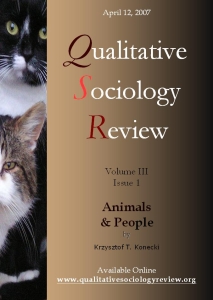Without words to get in the way: Symbolic interaction in prison-based animal programs
DOI:
https://doi.org/10.18778/1733-8077.3.1.07Keywords:
Symbolic interaction, Animals in prison, Human-animal interactionAbstract
George H. Mead ([1934] 1967) contended a person’s sense of self develops from language-based interactions with other humans in society. According to contemporary sociologists, a person’s sense of self is also influenced by non-verbal interactions with human and non-human animals. The present research extends Sanders (1993) work that examined how dog owners relate to their pets and come to develop a unique social identity for them. Through interviews with participants in prison-based animal programs (PAPs), this research explores whether inmates engaged in a similar process of assigning the animals with which they work a human-like identity. The implications of the relationships that develop in terms of desistance, which Maruna (2001) argued requires a redefinition of a person’s self-identity, are discussed.
Downloads
References
Alger, Janet and Steven Alger (1997) “Beyond Mead: Symbolic interaction between humans and felines.” Society and Animals 5(1):65-81.
Google Scholar
DOI: https://doi.org/10.1163/156853097X00222
Beck, Alan and Aaron Katcher (1996) Between Pets and People. West Lafayette, IN: Purdue University Press.
Google Scholar
Beck, Alan and Aaron Katcher (2003) “Future directions in human-animal bond research.” The American Behavioral Scientist 47:79-93.
Google Scholar
DOI: https://doi.org/10.1177/0002764203255214
Blumer, Herbert ([1969]1998) Symbolic Interactionism: Perspective and Method. Berkeley, CA: University of California Press.
Google Scholar
Bogdan, Robert and Steven Taylor (1989) “Relationships with severely disabled people: The social construction of humanness.” Social Problems 36:135-148.
Google Scholar
DOI: https://doi.org/10.2307/800804
Furst, Gennifer (2006) “Prison-based animal programs: A national survey.” The Prison Journal 86:407-430.
Google Scholar
DOI: https://doi.org/10.1177/0032885506293242
Irvine, Leslie (2004) “A model of animal selfhood: Expanding interactionist possibilities.” Symbolic Interaction 27:3-21.
Google Scholar
DOI: https://doi.org/10.1525/si.2004.27.1.3
Jerolmack, Colin (2005) “Our animals, our selves? Chipping away at the humananimal divide.” Sociological Forum 20:651-660.
Google Scholar
DOI: https://doi.org/10.1007/s11206-005-9063-2
Konecki, Krzysztof T. (2005) “The Problem of Symbolic Interaction and of Constructing Self.” Qualitative Sociology Review 1(1).
Google Scholar
DOI: https://doi.org/10.18778/1733-8077.1.1.05
Marino, Lori (2006) “The ape in the mirror.” Best Friends Magazine 15 (6):24-25.
Google Scholar
DOI: https://doi.org/10.2469/cfm.v17.n4.4199
Maruna, Shadd (2001) Making good: How ex-convicts reform and rebuild their lives. Washington, D.C.: American Psychological Association.
Google Scholar
DOI: https://doi.org/10.1037/10430-000
Maruna, Shadd and Thomas LeBel (2003) “Welcome back? Examining the ‘re-entry court’ concept from a strengths-based perspective.” Western Criminology Review 4:91-107.
Google Scholar
Maruna, Shadd, Thomas LeBel and Charles Lanier (2004) “Generativity behind bars: Some ‘redemptive truth’ about prison society.” Pp. 131-151 in The Generative society: Caring for future generations, edited by E. de St. Aubin, D. McAdams, and T. Kim. Washington, D.C.: American Psychological Association.
Google Scholar
DOI: https://doi.org/10.1037/10622-009
Maruna, Shadd, Thomas LeBel, Nick Mitchell and Michelle Naples (2004) “Pygmalion in the reintegration process: Desistance from crime through the looking glass.” Psychology, Crime & Law 10:271-281.
Google Scholar
DOI: https://doi.org/10.1080/10683160410001662762
Mead, George H. ([1934] 1967) Mind, Self, and Society. Chicago: University of Chicago Press.
Google Scholar
Myers, Olin (2003) “No longer the lonely species: A Post-Mead perspective on animals and sociology.” International Journal of Sociology and Social Policy 23:46- 68.
Google Scholar
DOI: https://doi.org/10.1108/01443330310790255
Sampson, Robert and John Laub (1990) “Crime and deviance over the life course: the salience of adult social bonds.” American Sociological Review 55:609-627.
Google Scholar
DOI: https://doi.org/10.2307/2095859
Sanders, Clinton (1990) “Excusing tactics: Social responses to the public misbehavior of companion animals.” Anthrozoos 4:82-90.
Google Scholar
DOI: https://doi.org/10.2752/089279391787057288
Sanders, Clinton (1993) “Understanding dogs: Caregivers’ attributions of mindedness in caninehuman relationships.” Journal of Contemporary Ethnography 22:205-226.
Google Scholar
DOI: https://doi.org/10.1177/089124193022002003
Sanders, Clinton (2003) “Actions speak louder than words: Close relationships between humans and nonhuman animals.” Symbolic Interaction 26:405-426.
Google Scholar
DOI: https://doi.org/10.1525/si.2003.26.3.405
Toch, Hans (2000) “Altruistic activity as correctional treatment.” International Journal of Offender Therapy and Comparative Criminology 44:270-278.
Google Scholar
DOI: https://doi.org/10.1177/0306624X00443002
Turner, Debbye (2006) “Odd Couples Among Animals.” Web page, April 19. Retrieved March 18, 2007 http://www.cbsnews.com/stories/2006/04/19/earlyshow/contributors/debbyeturner/main1512591_page2.shtml
Google Scholar
Downloads
Published
How to Cite
Issue
Section
License

This work is licensed under a Creative Commons Attribution-NonCommercial-NoDerivatives 4.0 International License.











